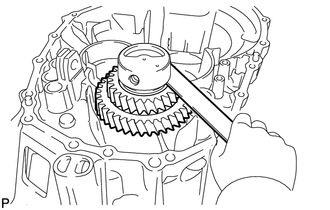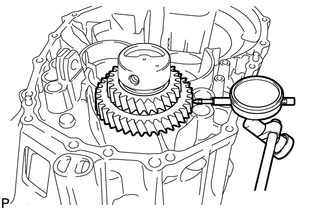Toyota Yaris: Manual Transaxle Unit / Inspection
INSPECTION
PROCEDURE
1. INSPECT REVERSE IDLER GEAR THRUST CLEARANCE
| (a) Using a feeler gauge, measure the reverse idler gear thrust clearance. Standard Clearance: 0.40 to 1.05 mm (0.0157 to 0.0413 in.) Maximum Clearance: 1.05 mm (0.0413 in.) If the clearance exceeds the maximum, replace the reverse idler gear, needle roller bearing, and reverse idler gear shaft. |
|
2. INSPECT REVERSE IDLER GEAR RADIAL CLEARANCE
| (a) Using a dial indicator, measure the reverse idler gear radial clearance. Standard Clearance: 0.015 to 0.048 mm (0.000591 to 0.00189 in.) Maximum Clearance: 0.048 mm (0.00189 in.) If the clearance exceeds the maximum, replace the reverse idler gear, needle roller bearing, and reverse idler gear shaft. |
|
 Disassembly
Disassembly
DISASSEMBLY PROCEDURE 1. REMOVE NO. 1 CLUTCH HOUSING COVER (a) Remove the No. 1 clutch housing cover from the front transaxle case.
2. REMOVE RELEASE CYLINDER BLEEDER PLUG CAP (a) Remove the release cylinder bleeder plug cap from the release cylinder bleeder plug...
 Neutral Position Switch
Neutral Position Switch
ComponentsCOMPONENTS ILLUSTRATION
*1 NEUTRAL POSITION SWITCH *2 GASKET *3 NO. 1 ENGINE UNDER COVER ASSEMBLY *4 ENGINE UNDER COVER LH
N*m (kgf*cm, ft...
Other information:
Toyota Yaris XP210 (2020-2025) Reapir and Service Manual: Installation
INSTALLATION CAUTION / NOTICE / HINT HINT: Use the same procedure for the RH side and LH side. The following procedure is for the LH side. PROCEDURE 1. INSTALL OUTER REAR VIEW MIRROR ASSEMBLY (a) Engage the clamp and claw to install the outer rear view mirror assembly...
Toyota Yaris XP210 (2020-2025) Reapir and Service Manual: Installation
INSTALLATION PROCEDURE 1. INSTALL MAIN BODY ECU (MULTIPLEX NETWORK BODY ECU) NOTICE: Make sure that the connecting surfaces are free of foreign matter. Do not touch the main body ECU (multiplex network body ECU) connector. (a) Set the main body ECU (multiplex network body ECU) to the position where the guide of the main body ECU (multiplex network body ECU) contacts the housing sidewall of the power distribution box assembly as shown in the illustration...
Categories
- Manuals Home
- Toyota Yaris Owners Manual
- Toyota Yaris Service Manual
- Auto Lock/Unlock Function
- Adjustment
- Fuse Panel Description
- New on site
- Most important about car
Break-In Period
No special break-in is necessary, but a few precautions in the first 600 miles (1,000 km) may add to the performance, economy, and life of the vehicle.
Do not race the engine. Do not maintain one constant speed, either slow or fast, for a long period of time. Do not drive constantly at full-throttle or high engine rpm for extended periods of time. Avoid unnecessary hard stops. Avoid full-throttle starts.

